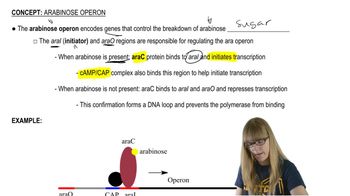Here are the essential concepts you must grasp in order to answer the question correctly.
Operon Model
The operon model is a genetic regulatory system found in bacteria, where a group of genes is controlled by a single promoter and regulated together. This model helps explain how genes are turned on or off in response to environmental changes, allowing bacteria to efficiently manage their metabolic processes.
Recommended video:
Repressible vs. Inducible Operons
Repressible operons, like the trp operon, are typically turned off and can be inhibited by the presence of a specific molecule, such as tryptophan. In contrast, inducible operons, such as the lac operon, are usually off and can be activated in response to an inducer, like lactose, allowing the bacteria to adapt to different nutrient sources.
Recommended video:
Gene Regulation Mechanisms
Gene regulation mechanisms involve various processes that control the expression of genes, including transcription factors, repressors, and activators. Understanding these mechanisms is crucial for distinguishing between different operon types, as they dictate how and when specific genes are expressed in response to cellular and environmental signals.
Recommended video:




